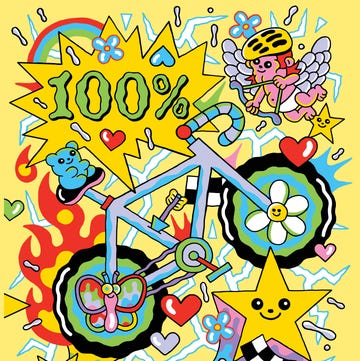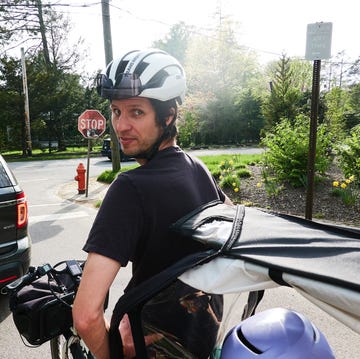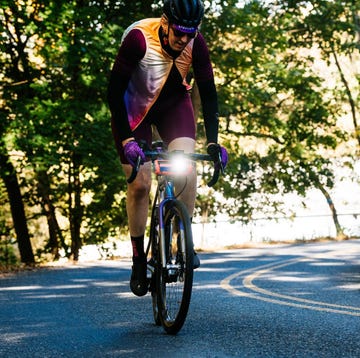Most people assume they only need a bike fit when things have become excruciatingly uncomfortable. But a bike fit isn’t just about alleviating discomfort.
It can help you get more efficient in your pedal stroke, feel vital if you’ve gained or lost fitness, and can allow your body to better heal from a nagging injury. Making a purchase sight unseen? A bike fit can guarantee that what you’re buying will actually fit you for the miles ahead. Avoid pain and frustration later on by anticipating all these surprising occasions where you might benefit from a fresh fit.
1) Change in Strength and/or Mobility
Whether because of a new lifting regimen at the gym or a weekly yoga class you finally committed to, an increase in strength or mobility/flexibility can be a reason for a bike fit adjustment. Similarly, a decrease in either your strength or mobility can also mean a tweak to your fit is needed.
Willie Swift, a bike fitter at Human Powered Health in Boston, Massachusetts, points out that if you’ve improved mobility, you may be able to get more aggressive in your position, folding a bit lower over the handlebar to improve aerodynamics. Similarly, if you’ve improved your core strength, you may also find it’s easier to stay in a more aero, low position for longer.
“If your mobility has changed for any reason, a bike fit is appropriate,” says Alyssa Hillaby, a registered physiotherapist and bike fitter in Ottawa, Ontario. “Because of this, usually we say that a bike fit lasts for around two years. If you think of yourself two years ago, your mobility and strength is absolutely different than it is now.”
Bought a New Type of Bike
If you’re new to mountain biking, your road bike measurements won’t perfectly translate to that new bike, and vice versa. Even gravel bikes versus road bikes differ enough in geometry, and in the way you would want to be positioned on each, that they won’t be exactly the same in terms of how they are set up. So, when you buy a new type of bike, you may need a new fit.
“Especially when going between different cycling disciplines, the optimal angles will change,” says Swift. “With time trial bikes, for example, the maximum extension is going to be slightly larger than it would be on a road bike or gravel bike because you don’t typically need the ability to be super nimble in your handling. And 80-centimeter mountain bike bars will mean a very different way of holding your upper body compared to your drop bars on your road bike.”
He does recommend riding your new bike a few times and trying to adjust your saddle height and fore/aft before heading in for a bike fit, though. This way, you’re more familiar with how the bike feels, as some of your discomfort may simply be from the new style of riding versus the fit itself.
Dealing With an Injury
There are plenty of smaller injuries you’ll be able to ride through, assuming you’re cleared by a doctor or physical therapist. But you may need a new fit to get comfortable. “If you lose some mobility in your hamstrings from an injury, that can change your fit needs,” Hillaby says. “Imagine trying to touch your toes with tight hamstrings. Every time you reach the bottom of your pedal stroke, as you’re bending your trunk to the handlebars, you’re essentially doing that same forward fold motion. Anything that changes your hamstring tension, whether it’s injury, overuse, or just not paying attention to mobility, will change how you feel on the bike, and that won’t just hurt your hamstrings—you’ll feel it in your low back.”
Hillaby explains that while your legs are doing the pedaling, you should think about your body as a whole, meaning a lack of mobility in one area can affect the entire in-ride feeling. “A common injury we see is a herniated disc or other back injury that’s making sitting on the saddle intolerable. And back injuries like compressed discs can even physically change your torso length, which can require a new fit.”
Finished With Injury Recovery
Once you’re fully healed from your injury or surgery aftermath and back to your old self again, the fit that was more comfort-focused and allowed you to ride as you recovered may no longer be the optimal one for you. “Your bike and your bike position should reflect you in this current moment in time,” says Swift. “Recovering from the injury is just as important as the injury itself—sometimes, we’ve made adjustments to the bike fit that were good during the recovery process but may be holding you back once you’re recovered.”
This is particularly important for injuries that necessitated changes to one side of the bike/body. “You might have made a positional change in order to let an injury heal, or to address an asymmetry,” Swift says. “Over time, with that new position, you might be able to heal that asymmetry, and then all of a sudden you’re not riding exactly the same as you were when we made that correction. In cases like that where you expect to improve, it’s good to have a checkup every six months or at least every year to make sure that it is moving in the right direction and you are healing from that specific deficiency that we were addressing in the first place.”
Postpartum
The pelvis changes a bit after giving birth, which means the saddle that felt great before may now feel a little “off.” You also may have lost some core strength, which can cause you to put more weight on the handlebar.
“Postpartum, a lot changes,” says Hillaby. “In general, it’s hard to maintain the same posture that you were able to pre-baby. And because cycling tends to be something that women can get back to relatively quickly postpartum, it’s even more important to make those fit adjustments.”
Major Change in Weight
If you’ve recently gained or lost a significant amount of weight, your bike fit needs may change. Your weight—and where you carry it—can dictate the angles that you’re able to hold on the bike. If you gain weight in your midsection, you may need to increase the upright position of your bike fit to offer extra belly room. If you lose weight in your midsection, you may be able to bend over the bars a bit lower and move into a more aggressive, aerodynamic position.
Don’t be surprised if even things that seemingly shouldn’t change with weight loss or gain suddenly feel different! Hillaby notes that with significant weight loss or weight gain, your current saddle may also need to be swapped for something that feels more comfortable. A cutout saddle may have felt good at a certain weight, but after losing 20 pounds, it starts to create issues with chafing.
Feeling “Stuck”
If you feel like you’ve plateaued in terms of the watts you’re able to hold, or you have the sense that you’re just not able to pedal as hard as you’d like to, a bike fit may help improve your efficiency. It can’t magically make you more powerful, but it can unlock your ability to pedal smoother at a higher power.
“We never claim that a bike fit is going to increase your power, but you might have an easier time maintaining that power,” says Hillaby. “I had a cyclist come in and we moved his seat up six centimeters, and while his power didn’t change, he was able to hold his previous 20-minute power for a full 40 minutes with that shift.”
Swift agrees—though he notes that a bad bike fit can certainly sap you of your ability to use the power you do have, so a fit may actually increase your watts in some cases. “We know that your on-bike position does have a pretty big impact on the amount of power that you can produce and how long you can withstand it, and which muscles you’re using the most,” he says. “We want to make sure that your fit is dialed in so you’re using your fitness as fully as possible.”
About to Buy a New Bike Online
If you’re planning to buy a new bike online, or the bike shop is ordering a certain bike just for you, a bike fit ahead of time can actually be a good idea—especially since the direct-to-consumer brands are often difficult to return or exchange without a lot of hassle. It seems counterintuitive to show up to a bike fit studio without your actual bike, but look for a studio that offers fits on a fitting bike like a Retül. “We do a pre-fit so we figure out which frames might be more appropriate for you before you buy,” says Hillaby. “If you’re going to buy a new bike, going to see a fitter to make sure you make the right investment, especially if you’re between two sizes on the company’s size chart or debating between two different bikes or brands, can be the best way to protect your investment.”
In these types of bike fits, you can bring in your current bike, and the fitter can help you see how the fit of the bike you’re drooling over online will differ from your current bike by setting up the fit bike to reflect your dream bike’s geometry. Hillaby notes that this is particularly useful for those of us who are on the short side and frequently struggle to fit on even the smallest size bikes, and for the taller folks who often have to buy the biggest frame and put the seatpost as high as it gets. “Bikes are just not made for people who are particularly tall or short,” she notes. “If you fall on one extreme or the other, a pre-buy bike fit can help you avoid bikes that just won’t work for you.”
Changed a Contact Point
Contact points—your cranks and pedals, your handlebars and hoods, and your saddle—can make a big difference in terms of your fit. Change one thing and it can cause serious downstream effects. “If you change one contact point, I’d ask your fitter for a quick follow up,” says Hillaby. “If you have changed two or more contact points, you should redo your fit entirely.”
A reason for a quick follow-up (that’s often free or extremely cheap) would be getting new shoes and cleats. “A follow-up might be a good idea to make sure everything is set up as it was on the old shoes,” Hillaby says. (This is especially true if you were making a lot of cleat adjustments in order to get comfortable during your original fit.)
A more thorough re-fit would be warranted if you swapped to a new set of smaller hoods on your handlebar after switching to electronic shifting, and also switched to 165mm cranks from your old 170mm cranks. “In that case, you should get a new fit because the reach and your seat height have changed,” says Hillaby. Surprised to hear your seat height changed just from swapping cranks? Because seat height is measured from the pedal at the lowest position to the saddle, subtracting five millimeters from the crank length actually lowers your seat height by five millimeters!
You Just Don’t Want to Ride
The last reason to get a bike fit is a big one that Swift hears about from clients. “It’s very important for us to listen to our bodies, and furthermore, listen to our emotions,” he says. “I think the way that you are feeling, both physically and emotionally, can tell you a lot. To me, a really good indicator it might be worth considering checking your position on a bike is when you start having this sense of dread or disinterest in riding. If you’re not physically fatigued, yet you still have the feeling that you just don’t want to ride, I think that’s a really good time to investigate your position. Sometimes there’s a small tweak that can be made to your fit that completely changes how the ride feels.”
Cycling culture loves to brag about how tough cyclists are—you push through the pain, you do the sufferfest, you tell your legs to shut up. But Swift says these small issues causing pain and discomfort aren’t always meant to be “pushed through.” Often, they can be addressed, and those small discomforts can be solved so you can truly enjoy the ride and maximize your cycling potential.
When NOT to Get a New Fit
Lastly, there is one time when you shouldn’t get a new fit: When you just got a bike fit. “If you recently got a professional fit, it’s important to not make too many adjustments right after the fit for a little while,” says Swift. “It can take time to get used to a new fit, and it may feel a bit awkward at first, even if it is an improvement. Unless there’s real pain, wait at least a month before getting another fit. Give your body time to adjust.”

Molly writes about cycling, nutrition and training with an emphasis on bringing more women into sport. She's the author of nine books including the Shred Girls series and is the founder of Strong Girl Publishing. She co-hosts The Consummate Athlete Podcast and spends most of her free time biking and running on trails, occasionally joined by her mini-dachshund.













